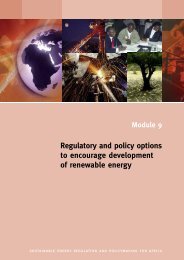Increasing access to energy services in rural areas - REEEP ...
Increasing access to energy services in rural areas - REEEP ...
Increasing access to energy services in rural areas - REEEP ...
You also want an ePaper? Increase the reach of your titles
YUMPU automatically turns print PDFs into web optimized ePapers that Google loves.
MODULE 10: INCREASING ACCESS TO ENERGY SERVICES IN RURAL AREAS<br />
page 10.65<br />
3. The NPV of the <strong>to</strong>tal subsidy is divided by the <strong>to</strong>tal number of benefit po<strong>in</strong>ts that have<br />
accrued, giv<strong>in</strong>g a cost per benefit po<strong>in</strong>t of the project.<br />
Once projects have been selected and packaged for development by the M<strong>in</strong>istry of Energy<br />
and/or the REA (or other appropriate body) the real prioritization will depend on the<br />
response and on specific requirements from private <strong>in</strong>ves<strong>to</strong>rs and the f<strong>in</strong>ancial <strong>in</strong>stitutions.<br />
The follow<strong>in</strong>g are examples of criteria that can be used for further analysis and prioritization:<br />
4. Capital Cost per Connection analysis does not take <strong>in</strong><strong>to</strong> account the Life Cycle Cost<strong>in</strong>g<br />
(LCC) or overall project viability, so projects, which could well, be viable may still show<br />
the highest Capital Cost per Connection. This approach <strong>to</strong> prioritization is thus very limited.<br />
5. Subsidy Analysis takes <strong>in</strong><strong>to</strong> account the full LCC and O&M costs, as well as determ<strong>in</strong><strong>in</strong>g<br />
the subsidy that which will result <strong>in</strong> sett<strong>in</strong>g tariffs at affordable levels. Projects that<br />
require no subsidy are clearly favoured over those requir<strong>in</strong>g large subsidy. The Subsidy<br />
Required per Connection shows clearly which projects are most viable and which are<br />
not, but does not always clearly rank the projects.<br />
6. Benefit Po<strong>in</strong>ts Analysis gives a more useful overall rank<strong>in</strong>g.<br />
7. If projects do not fit with<strong>in</strong> these Benefit Po<strong>in</strong>t Analysis Criteria, then it is possible that<br />
some of the less economical l<strong>in</strong>es or components would have <strong>to</strong> be excluded from the<br />
project.<br />
8. A further criterion for rank<strong>in</strong>g would be that projects must have a m<strong>in</strong>imum number of<br />
BPs <strong>to</strong> be considered. If this were not done, large numbers of applications <strong>in</strong>volv<strong>in</strong>g<br />
many t<strong>in</strong>y projects may result <strong>in</strong> the larger projects be<strong>in</strong>g neglected.<br />
Step 5: Regional equity adjustment<br />
Follow<strong>in</strong>g the prioritization of projects, the rank<strong>in</strong>gs could then be adjusted depend<strong>in</strong>g on<br />
other external <strong>in</strong>fluenc<strong>in</strong>g criteria:<br />
• Fund<strong>in</strong>g contributions from non-government sources;<br />
• Transmission grid and distribution network transfer capacity and security of supply;<br />
• Supply capacity available, scheduled load-shedd<strong>in</strong>g;<br />
• Generation capacity expansion programmes;<br />
• Grid and network expansion programmes;<br />
• Distributed (“<strong>in</strong>-project”) electricity generation;<br />
• Respective proportions of costs of transmission/distribution re<strong>in</strong>forcement and reticulation;<br />
• Political expectations;<br />
• Poverty alleviation policy and projects;<br />
• Regional equity (see further comments below).










